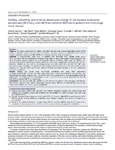Validity, reliability and minimal detectable change of the balance evaluation systems test (BESTest), mini-BESTest and brief-BESTest in patients with end-stage renal disease

Date
2017-09-08Author
Subject
Metadata
Show full item recordAbstract
PURPOSE: This study determined the validity, test-retest reliability and minimal detectable change of the balance evaluation systems test (BESTest), mini-balance evaluation systems test (Mini-BESTest) and brief-balance evaluation systems test (Brief-BESTest) in patients with end-stage renal disease. METHODS: A cross-sectional study with 74 patients with end-stage renal disease (male 66.2%; 63.9 ± 15.1 years old) was conducted. Participants were asked to report the number of falls during the previous 12 months and to complete the activity-specific balance confidence (ABC) scale. The BESTest was administered, and the Mini-BESTest and Brief-BESTest scores were computed based on the BESTest performance. Validity was assessed by correlating balance tests with each other and with the ABC scale. Test-retest relative reliability and agreement were explored with the intraclass correlation coefficient (ICC) equation (2,1) and the Bland and Altman method. Minimal detectable changes at the 95% confidence level were established. RESULTS: Balance test scores were significantly correlated with each other (spearman's correlation = 0.89-0.92) and with the ABC scale (spearman's correlation = 0.49-0.59). Balance tests presented high test-retest reliability (ICC = 0.84-0.94), with no evidence of bias. Minimal detectable change values were 10.8 (expressed as a percentage 13.5%), 5.3 (23.7%) and 5.6 (34%) points for the BESTest, Mini-BESTest and Brief-BESTest, respectively. CONCLUSIONS: All tests are valid and reliable to assess balance in patients with end-stage renal disease. Nevertheless, based on the minimal detectable changes found, BESTest and Mini-BESTest may be the most recommended tests for this specific population. Implications for Rehabilitation Balance evaluation systems test (BESTest), mini-balance evaluation systems test (Mini-BESTest) and brief-balance evaluation systems test (Brief-BESTest) are reliable and valid in patients with end stage renal disease (ESRD). The minimal detectable changes of 10.8 for the BESTest, 5.3 for the Mini-BESTest and 5.6 for the Brief-BESTest can be used by clinicians to identify a true change in balance over time or in response to interventions. Based on the minimal detectable changes found, BESTest and Mini-BESTest may be the most recommended; and the selection of one of them may be based on time and equipment availability.
Description
Collections
Publisher
Place of Publication
Journal
Volume
Issue
Pagination
Author URL
Recommended, similar items
The following license files are associated with this item:

